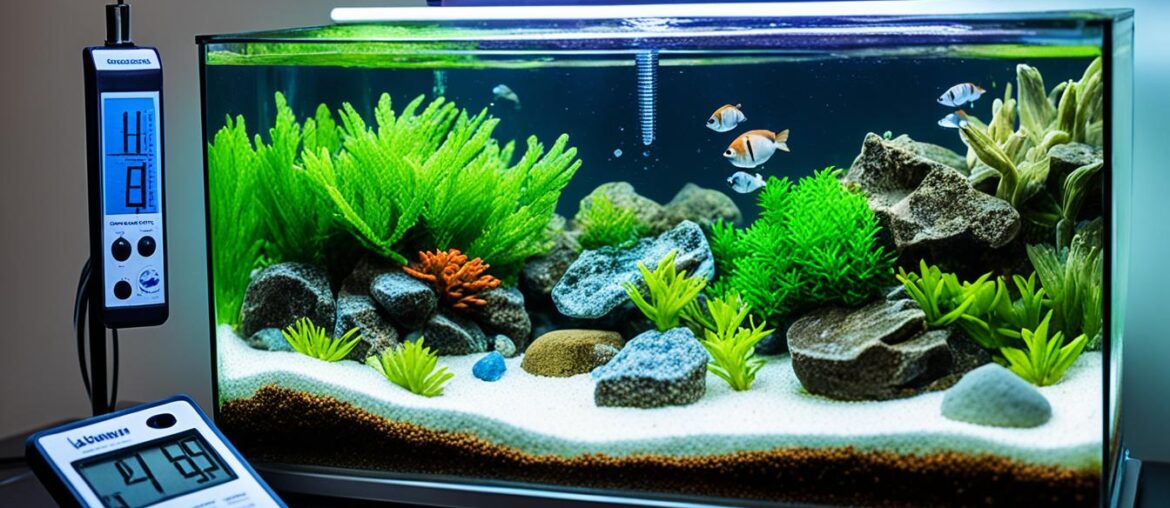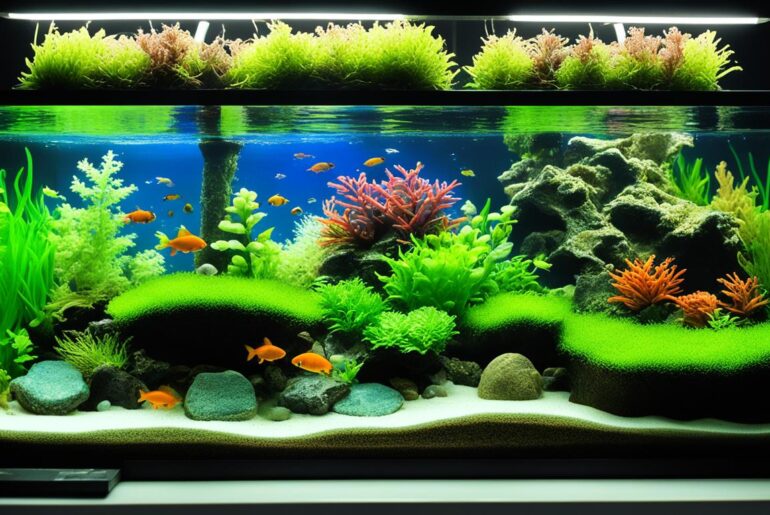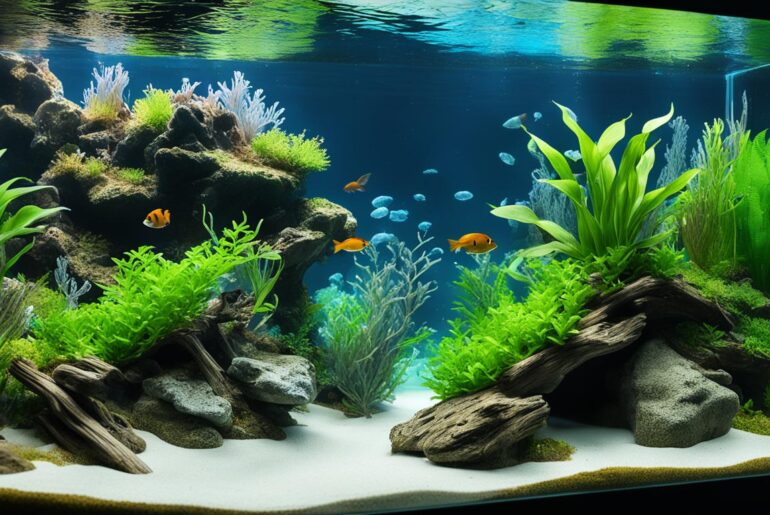Growing up, I always had a fascination with aquariums. The vibrant colors of the fish, the serene underwater world—the entire experience captivated me. So when I finally decided to set up my own aquarium, I was beyond excited. Little did I know that there was a crucial process I needed to go through before introducing any fish.
As a beginner, I quickly learned about the importance of fishless cycling—an essential step in creating a healthy and thriving aquarium. This process involves establishing the bacterial colonies necessary to remove toxic waste in the tank. It creates a balanced ecosystem and prevents the harmful effects of ammonia and nitrite on aquatic life.
Embarking on the journey of fishless cycling can be overwhelming for beginners, but fear not! In this article, I will guide you through the 10 steps to master fishless cycling methods for beginners. By following these steps, you can ensure a healthy start for your aquarium and create an optimal environment for your fish and other livestock.
Before we dive into the details, let’s take a look at some key takeaways:
Key Takeaways:
- Fishless tank cycling is essential to establish bacterial colonies and remove toxic waste.
- The process involves four basic steps: ammonia dosing, maintaining ammonia and monitoring nitrite, performing a large water change to reduce nitrate, and stocking the aquarium.
- Required equipment includes an ammonia source, water test kit, and water conditioner.
- Ammonia dosing stimulates the growth of bacteria that convert ammonia to nitrite.
- Monitoring ammonia, nitrite, and nitrate levels throughout the process is crucial for ensuring a successful fishless cycle.
Now, let’s dive deep into the world of fishless cycling and discover the step-by-step process to master this essential technique.
The Importance of Fishless Tank Cycling
Fishless tank cycling plays a crucial role in establishing the necessary bacterial colonies that remove toxic waste from the aquarium. This process is a vital part of the fish tank nitrogen cycle, which involves the conversion of ammonia to nitrite and then to nitrate by different species of bacteria. By completing the fishless cycling process before adding fish, beginners can ensure a safe and healthy environment for their aquatic pets.
The importance of fishless cycling lies in creating a balanced ecosystem within the aquarium. By establishing bacterial colonies through this process, you can prevent toxic ammonia and nitrite levels that can harm fish and other livestock. This method allows for the efficient removal of toxic waste, ensuring a stable and optimal environment for your aquatic pets.
Fishless tank cycling provides several benefits that contribute to the overall well-being of your aquarium. Some of these benefits include:
- Promoting the growth of beneficial bacteria necessary for maintaining water quality
- Preventing the build-up of harmful ammonia and nitrite levels
- Establishing a stable biological filter that can handle the waste produced by fish
- Creating a healthy and thriving ecosystem for your aquarium inhabitants
To summarize, fishless tank cycling is of utmost importance when setting up a new aquarium. It ensures the establishment of bacterial colonies that effectively remove toxic waste, creating a safe and optimal environment for your fish and other aquatic pets.
Expert Opinion
“Fishless tank cycling is an essential step in creating a healthy aquarium for your fish and other aquatic pets. By establishing bacterial colonies that remove toxic waste, you can maintain optimal water conditions and provide a safe environment for your aquatic inhabitants.” – Dr. Claire Johnson, Aquatic Biologist
Data Comparison
| Traditional Fish-in Cycling | Fishless Tank Cycling |
|---|---|
| Risk of fish stress and injury | No risk to fish during the cycling process |
| High ammonia and nitrite spikes | Controlled ammonia and nitrite levels |
| Potential fish loss due to toxic water conditions | Reduced risk of fish loss |
| Slower establishment of beneficial bacteria | Faster establishment of bacterial colonies |
| Inconsistent water parameters | Stable and optimal water conditions |
Required Equipment for Fishless Tank Cycling
To successfully carry out fishless tank cycling, beginners will need a few essential pieces of equipment. These include:
- Ammonia Source: An ammonia source is necessary to kickstart the nitrogen cycle. You can choose between using liquid ammonia or specific aquarium ammonia products. Both options effectively provide the required ammonia for bacterial growth.
- Water Test Kit: A reliable water test kit is essential for monitoring the progress of the tank cycle. It allows you to regularly measure the levels of ammonia, nitrite, and nitrate in the water. This helps you track the development of the bacterial colonies and ensures the cycling process is on track.
- Water Conditioner: When filling your aquarium with tap water, it’s crucial to use a water conditioner. This product removes chlorine and chloramine, which are harmful to both fish and beneficial filter bacteria. By conditioning the water, you create a safer environment for the aquarium inhabitants and promote the growth of healthy bacterial colonies.
Having these essential equipment items on hand will set you up for success in fishless tank cycling. They provide the necessary tools for establishing a healthy and thriving aquarium ecosystem.
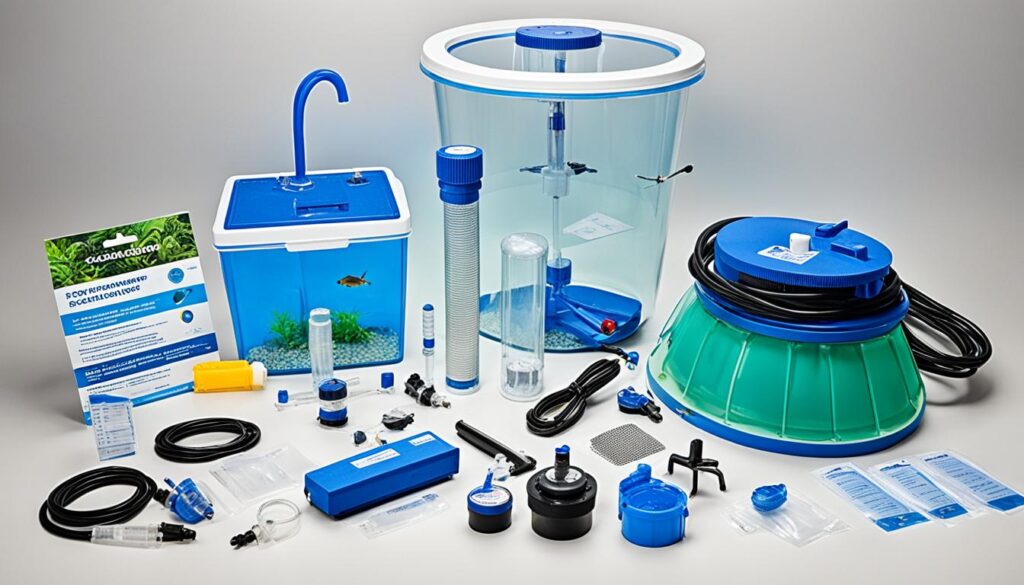
Required Equipment for Fishless Tank Cycling
| Equipment | Description |
|---|---|
| Ammonia Source | Liquid ammonia or specific aquarium ammonia products |
| Water Test Kit | Allows for measurement of ammonia, nitrite, and nitrate levels |
| Water Conditioner | Removes chlorine and chloramine from tap water |
The Four Basic Steps of Fishless Tank Cycling
Now that we understand the importance of fishless tank cycling and have the required equipment, let’s dive into the four basic steps of the fishless cycling process. Following these steps will ensure the establishment of healthy bacterial colonies and a balanced nitrogen cycle in your aquarium.
Step 1: Ammonia Dosing
To kickstart the fishless cycling process, we need to introduce ammonia into the tank. This simulates the waste produced by fish and provides food for the beneficial bacteria that will eventually convert ammonia into less harmful forms.
You can use liquid ammonia or specific aquarium ammonia products to achieve a concentration of 4ppm. To maintain accuracy, it’s recommended to use an online calculator or follow product instructions for precise dosing. Once you’ve added the ammonia, test the levels with a water test kit.
Remember, during this step, we’re promoting the growth of Nitrosomonas bacteria, which convert ammonia to nitrite. Therefore, it’s crucial to monitor and maintain ammonia levels at 4ppm by further dosing if necessary.
Step 2: Maintaining Ammonia and Monitoring Nitrite
In step 2, we focus on maintaining the ammonia levels and monitoring the presence of nitrite. Daily testing using a water test kit allows us to keep track of the progress and ensure the bacterial colonies are thriving.
Continue testing for ammonia and adjust levels as needed to maintain a concentration of 4ppm. Additionally, monitor nitrite levels every other day. The appearance of nitrite indicates the cycle has started and conversion from ammonia to nitrite is underway.
Step 3: Large Water Change to Reduce Nitrate
Performing a large water change is crucial to reduce nitrate levels in the aquarium. Nitrate is less harmful than ammonia and nitrite, but excessive levels can still be detrimental to fish and other aquatic life.
Regularly test for nitrate using a water test kit. When nitrate levels reach around 40ppm, perform a large water change to dilute the concentration. Repeat this process as necessary until the nitrate levels are within safe limits.
Step 4: Stocking the Aquarium
Finally, once ammonia and nitrite levels are consistently reading 0ppm, and nitrate levels are within safe limits, the aquarium is ready for stocking. Introduce fish and other livestock, providing a nitrogen nutritional source for the filter bacteria.
When choosing fish, consider their compatibility with each other and the appropriate number for your tank size. Ensure that you do not overstock to maintain a healthy and balanced environment for your aquatic pets.
By following these four steps, you will successfully complete the fishless cycling process and establish a stable and healthy environment for your aquarium inhabitants. Now let’s move on to the final test to ensure your tank is ready for its new inhabitants.
Step 1 – Ammonia Dosing
The first step in fishless tank cycling is setting up the aquarium and equipment. Start by filling the aquarium with water and treating it with a water conditioner to remove any harmful chemicals. This is crucial to provide a safe environment for the fish and beneficial bacteria.
Once the aquarium is ready, it’s time to add ammonia. Ammonia is an essential component for stimulating the growth of Nitrosomonas bacteria, which play a crucial role in converting ammonia to nitrite. To achieve the optimal concentration of ammonia, aim for 4ppm. This can be done by using a liquid ammonia source or utilizing an online calculator for precise dosing.
After adding the ammonia, it’s important to regularly test the ammonia levels using a water test kit. This will help you monitor the progress of the cycling process and ensure that the ammonia concentration remains stable.
Pro tip: Ammonia levels can be adjusted if necessary to maintain the desired 4ppm concentration.
| Step 1: Ammonia Dosing |
|---|
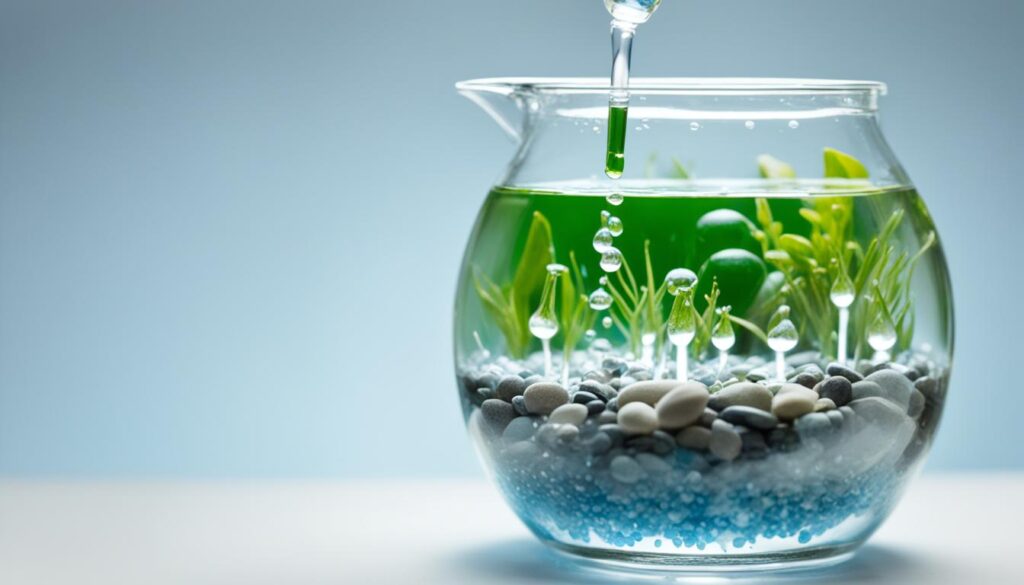
|
|
Step 2 – Maintaining Ammonia and Monitoring Nitrite
In step 2 of the fishless tank cycling process, it is crucial to maintain ammonia levels and monitor the presence of nitrite. By doing so, we can ensure the successful establishment of bacterial colonies and the progression of the nitrogen cycle.
Maintaining Ammonia Levels:
To maintain the desired ammonia concentration of 4ppm, it is important to perform daily testing and adjust as necessary. Using a reliable water test kit, we can measure the ammonia levels in the aquarium and make any required adjustments. By providing a consistent source of ammonia, we promote the growth of the appropriate bacteria responsible for converting ammonia to nitrite.
Monitoring Nitrite:
The presence of nitrite is an important indication that the cycling process is underway. Nitrite is produced by bacteria as they convert ammonia to nitrite, and its presence signifies that the bacterial colonies are thriving. To monitor nitrite levels, it is recommended to test every other day using a water test kit. This allows us to track the progress of the bacteria and ensure that they are effectively converting ammonia to nitrite.

Monitoring both ammonia and nitrite levels provides valuable insights into the progression of fishless tank cycling. It allows us to gauge the effectiveness of the bacterial colonies and their ability to convert toxic ammonia to nitrite, which is a crucial step in creating a healthy and balanced aquarium environment.
Now that we understand the importance of maintaining ammonia levels and monitoring nitrite, let’s move on to step 3, which involves performing a large water change to reduce nitrate levels and maintain water quality.
Step 3 – Large Water Change to Reduce Nitrate
Reducing nitrate levels is a critical step in maintaining water quality and ensuring a healthy aquarium environment. High nitrate levels can be harmful to fish and other livestock, so it’s important to perform regular water changes to keep nitrate levels within safe limits.
A large water change is necessary to effectively reduce nitrate levels in the aquarium. By replacing a significant portion of the water, you can dilute the nitrate concentration and promote a healthier environment for your aquatic pets.
Performing a water change is a straightforward process. Here’s how to do it:
- Prepare the water for the water change by treating it with a water conditioner. This removes chlorine and other harmful chemicals from tap water.
- Using a siphon or aquarium vacuum, carefully remove approximately 20-30% of the water from the aquarium. This will help remove excess nitrate and other pollutants.
- After removing the water, replace it with fresh, treated water at the same temperature as the aquarium.
- Ensure that the water is properly mixed and circulated before reintroducing fish and other livestock to the tank.
Performing regular water changes not only reduces nitrate levels but also helps maintain overall water quality. Additionally, it promotes the growth of beneficial bacterial colonies that play a crucial role in the nitrogen cycle. These bacteria help convert harmful compounds like nitrite to less toxic nitrate, ensuring a healthier and more stable aquarium environment.
“Regular water changes are essential for maintaining optimal water quality and reducing nitrate levels in the aquarium.”
Remember to monitor nitrate levels regularly using a reliable water test kit. The ideal nitrate level for most aquariums is below 40ppm. If the nitrate levels exceed this threshold, continue performing water changes until the desired level is reached.
By incorporating regular water changes into your aquarium maintenance routine, you can effectively reduce nitrate levels, promote bacterial growth, and maintain a healthy and thriving aquatic ecosystem.
| Benefits of Performing Water Changes: | Promotes a healthy aquarium environment | Reduces nitrate levels | Maintains optimal water quality | Supports the growth of beneficial bacteria |
|---|---|---|---|---|
| Importance |  |
High | High | High |
Step 4 – Stocking the Aquarium
After completing the fishless tank cycling process and achieving consistently low levels of nitrite and ammonia (0ppm) with the help of the bacterial colonies, it is time to stock your aquarium. This exciting step allows you to introduce fish and other livestock, creating a vibrant and lively underwater ecosystem.
When stocking your aquarium, it is crucial to consider the types of fish and livestock that are suitable for your tank size and compatible with each other. Research the specific needs and characteristics of the species you are interested in to ensure a harmonious environment and minimize any potential conflicts.
Introducing fish and other livestock to your tank also provides a crucial nitrogen nutritional source for the filter bacteria. As the fish produce waste, the bacteria in the aquarium’s biological filter will use it as a nutrient, completing the nitrogen cycle.
Remember, it is essential to stock the aquarium soon after completing the cycling process to provide a continuous food source for the established bacteria. Delaying the stocking process may result in a decline of the bacterial colonies as they lack a sufficient nitrogen source.
Tip: Before adding fish to your aquarium, it is recommended to observe a “fishless cycle” for a few days. This involves introducing a small amount of ammonia to ensure that the filter bacteria are actively consuming it, demonstrating that the cycle is functioning correctly.
Stocking Guidelines
To ensure a successful aquarium stocking, follow these guidelines:
- Gradually introduce new fish and livestock to the aquarium to allow them to acclimate to the new environment.
- Do not overcrowd the tank. Consider the adult size of the species you are adding and provide enough space for them to swim comfortably.
- Balance the species in terms of behavior and swimming patterns. Having a variety of fish that occupy different levels of the tank (top, mid, and bottom dwellers) can create a visually appealing and harmonious environment.
- Regularly monitor the water parameters, including ammonia, nitrite, nitrate, pH, and temperature, to ensure a healthy and stable environment for your aquarium inhabitants.
- Consider the compatibility of the different species in terms of water requirements, temperament, and feeding habits.
By following these stocking guidelines, you can establish a balanced and thriving aquarium ecosystem, providing a comfortable and enjoyable habitat for your fish and other livestock.
Popular Fish for Stocking Beginner Aquariums
| Fish Name | Water Type | Temperature Range | Adult Size (inches) | Behavior |
|---|---|---|---|---|
| Tetra Fish | Neutral, slightly acidic | 72-82°F | 1-3 | Schooling, peaceful |
| Platy | Neutral | 70-82°F | 1.5-2.5 | Active, peaceful |
| Guppy | Neutral | 70-82°F | 1.5-2.5 | Active, peaceful |
| Betta Fish | Neutral, slightly acidic | 76-82°F | 2.5-3 | Solitary, can be aggressive |
| Corydoras Catfish | Neutral | 72-80°F | 2-3 | Bottom-dwelling, peaceful |
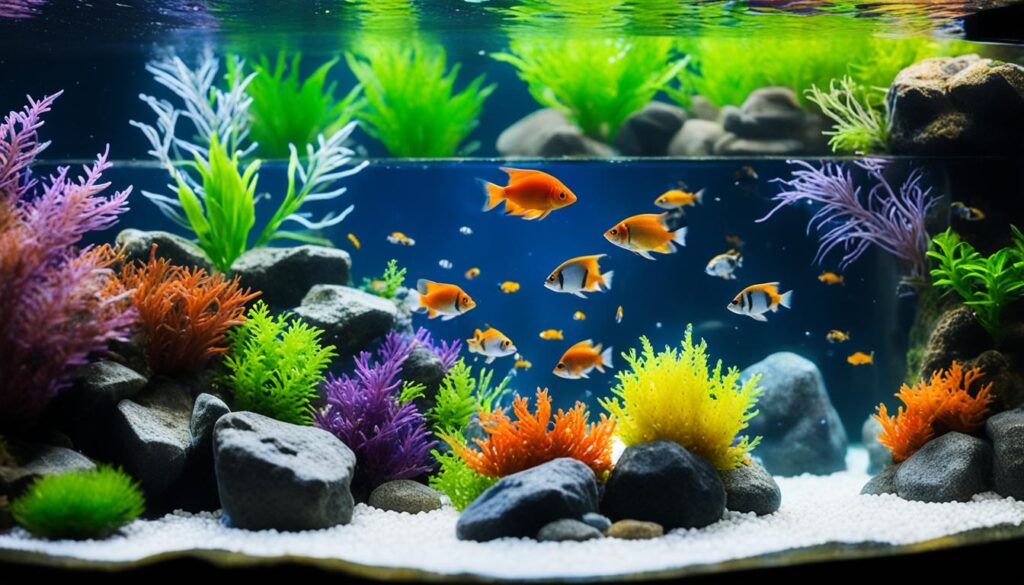
Remember, when selecting fish for your aquarium, it’s important to consider their specific care requirements and compatibility with other species. This table provides a starting point, but always conduct thorough research to ensure the best possible care for your aquatic pets.
Final Test
Before concluding the fishless tank cycling process, it is crucial to perform a final test to ensure stable water parameters. Monitoring the levels of ammonia, nitrite, and nitrate is essential in maintaining a healthy and balanced aquarium environment.
The first step is to use a water test kit to measure the concentration of these compounds in the water. The goal is to have both ammonia and nitrite levels read 0ppm, indicating that the bacterial colonies responsible for converting these harmful compounds are established and functioning effectively. A test result of 0ppm for ammonia and nitrite confirms that the tank has completed the cycling process successfully.
While ammonia and nitrite levels should be at 0ppm, nitrate levels will be present. However, the nitrate levels should be within safe limits for fish and other aquatic life. Keeping nitrate levels below 40ppm is recommended to ensure a healthy living environment for your aquarium inhabitants.
To maintain stable water parameters, regular testing is beneficial. Monitoring ammonia and nitrite levels periodically can help detect any fluctuations and address them promptly to prevent any harm to the fish. Additionally, regular water changes and proper maintenance of the aquarium can contribute to stable water conditions.
By performing this final test and ensuring stable water parameters, you can be confident that your fishless tank cycling process has been successful. Your aquarium is now ready for the next exciting step – stocking it with your desired fish and other aquatic creatures.
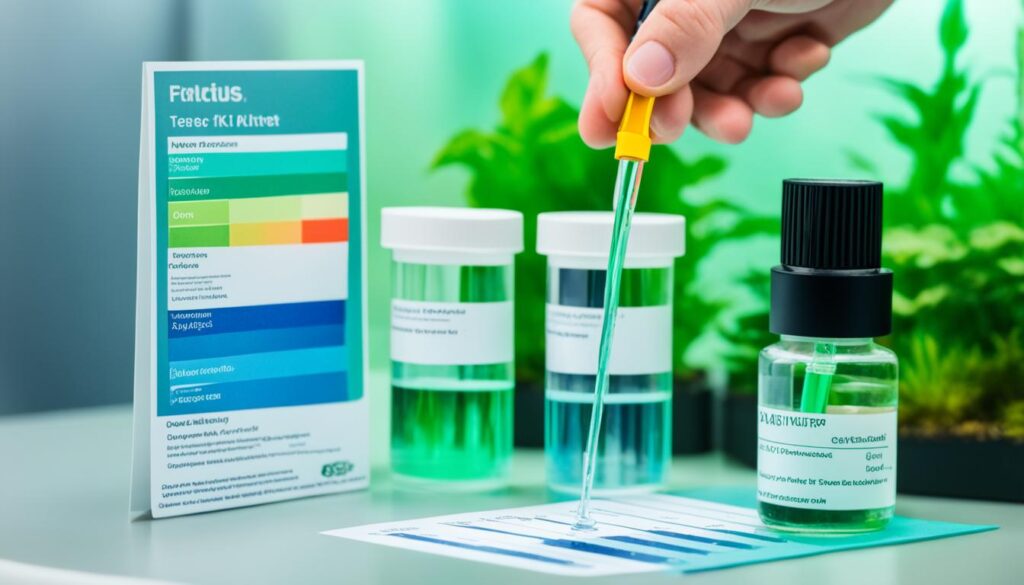
Monitoring water parameters is crucial for maintaining a healthy aquarium environment.
Conclusion
Fishless tank cycling is an essential process for beginners to establish a healthy and balanced aquarium environment. By following the step-by-step guide and diligently maintaining ammonia, nitrite, and nitrate levels, you can ensure the success of your fishless cycling journey. Patience and consistency are key as it takes time for bacterial colonies to establish.
With a well-cycled aquarium, you can provide a safe and optimal environment for your fish and other aquatic livestock. Fishless cycling allows the establishment of the necessary bacterial colonies that help remove toxic waste, creating a balanced ecosystem. By completing this process before adding fish, you prevent harmful ammonia and nitrite levels, ensuring the well-being of your aquatic pets.
Remember to equip yourself with the necessary tools such as an ammonia source, a reliable water test kit, and a water conditioner. These essentials will support you in monitoring the progress of the tank cycle and maintaining water quality throughout the process. By carefully following the four basic steps of fishless tank cycling – ammonia dosing, maintaining ammonia and monitoring nitrite, performing a large water change to reduce nitrate, and finally, stocking the aquarium – you can achieve a successfully cycled tank and enjoy a thriving aquatic environment.
FAQ
What is fishless tank cycling?
Fishless tank cycling is the process of establishing the necessary bacterial colonies in a newly set-up aquarium to remove toxic waste. It is part of the nitrogen cycle, which involves the conversion of ammonia to nitrite and then to nitrate by different species of bacteria.
Why is fishless tank cycling important?
Fishless tank cycling is important to create a balanced ecosystem in the aquarium and prevent harmful ammonia and nitrite levels. It establishes a healthy environment for fish and other livestock, ensuring their safety and well-being.
What equipment do I need for fishless tank cycling?
To successfully carry out fishless tank cycling, you will need an ammonia source, a water test kit to monitor ammonia, nitrite, and nitrate levels, and a water conditioner to remove chlorine and chloramine from tap water.
What are the four basic steps of fishless tank cycling?
The four basic steps of fishless tank cycling are ammonia dosing, maintaining ammonia levels and monitoring nitrite, performing a large water change to reduce nitrate, and finally, stocking the aquarium with fish and other livestock.
How do I perform ammonia dosing in fishless tank cycling?
Ammonia dosing involves adding ammonia to the aquarium to reach a concentration of 4ppm. This can be done using a liquid ammonia source or an online calculator for precise dosing. Ammonia levels should be tested and adjusted if necessary to maintain the desired concentration.
How do I maintain ammonia levels and monitor nitrite during fishless tank cycling?
Ammonia levels should be maintained at 4ppm by daily testing and adjustment if necessary. Nitrite levels should also be monitored every other day as the bacteria colony responsible for converting ammonia to nitrite starts to grow. Testing helps track the progress of the bacterial colonies.
Why is a large water change necessary in fishless tank cycling?
Performing a large water change helps reduce nitrate levels in the aquarium, ensuring water quality and promoting the growth of bacterial colonies responsible for converting nitrite to nitrate. Several significant water changes may be needed to achieve the desired nitrate level.
When can I stock the aquarium after fishless tank cycling?
Once the cycling process is complete and ammonia and nitrite levels consistently read 0ppm, the aquarium is ready for stocking. Fish and other livestock can be introduced to provide a nitrogen nutritional source for the filter bacteria. It is important to stock the aquarium soon after cycling is complete.
How do I perform a final test in fishless tank cycling?
Before concluding the fishless tank cycling process, perform a final test to ensure stable water parameters. This includes monitoring ammonia, nitrite, and nitrate levels using a water test kit. The aim is to have ammonia and nitrite levels read 0ppm, indicating the successful establishment of bacterial colonies.
